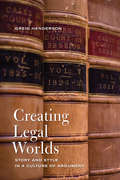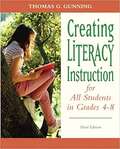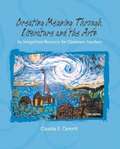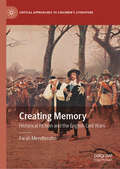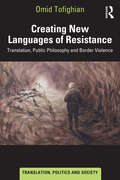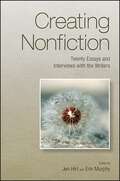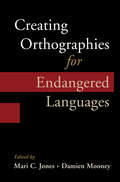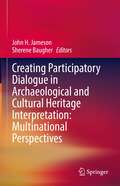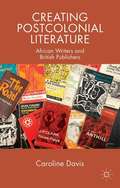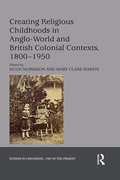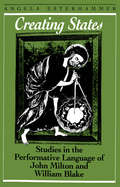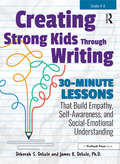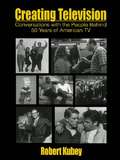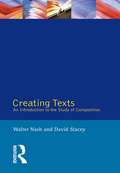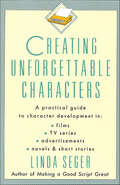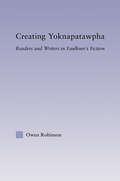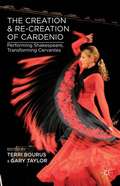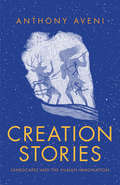- Table View
- List View
Creating Legal Worlds
by Greig HendersonA legal judgment is first and foremost a story, a narrative of facts about the parties to the case. Creating Legal Worlds is a study of how that narrative operates, and how rhetoric, story, and style function as integral elements of any legal argument.Through careful analyses of notable cases from Canada, the United States, and the United Kingdom, Greig Henderson analyses how the rhetoric of storytelling often carries as much argumentative weight within a judgement as the logic of legal distinctions. Through their narrative choices, Henderson argues, judges create a normative universe - the world of right and wrong within which they make their judgements - and fashion their own judicial self-images. Drawing on the work of the law and literature movement, Creating Legal Worlds is a convincing argument for paying close attention to the role of story and style in the creation of judicial decisions.
Creating Literacy Instruction For All Children In Grades Pre-K to 4
by Thomas G. GunningIn response to today's need to tailor instruction for the lower grades (PreK-4), this comprehensive, practical guide gives aspiring and practicing professionals the methods and techniques they need to become highly effective teachers who are well equipped to help all students become proficient readers and writers. Creating Literacy Instruction for All Children in Grades Pre-K to 4 features lesson plans for virtually every major literacy skill or strategy, abundant lists of recommended children's reading, helpful student strategies, numerous reinforcement activities, and real-life illustrations of exemplary teaching, all designed to help teachers incorporate today's most effective teaching methods and techniques into their literacy teaching.
Creating Literacy Instruction For All Students In Grades 4 To 8
by Thomas G. GunningCreating Literacy Instruction for All Students in Grades 4 to 8 gives teachers the best available teaching strategies and sample step-by-step lesson plans for constructing lively, effective reading and writing instruction for all students. With his focus on teaching successfully in today’s diverse classrooms, renowned author Thomas Gunning gives teachers a head start in ensuring quality literacy instruction for all children.
Creating Meaning Through Literature and the Arts: An Integration Resource for Classroom Teachers (Third Edition)
by Claudia E. CornettThe most comprehensive text on arts integration in the market, this bestseller redefines literacy in light of the 21st century need for multiple literacies. It provides an overview of academically linked research in five arts areas: literary arts, visual art, drama, dance, and music, and is intended as a complete introduction to how to meaningfully use the arts as teaching tools on a daily basis in every curricular area. Organized around WHAT, WHY and HOW questions, Creating Meaning through Literature and the Arts, 5/e tells the story of how arts integration (AI) has grown so much in a few decades using the story of hundreds of arts-based schools–old and new, public, magnet, and charter, today’s. Each AI school story draws upon cutting edge research, evolving state standards, and constructivist beliefs to transform teaching and learning. The Enhanced Pearson eText features video resources.
Creating Memory: Historical Fiction and the English Civil Wars (Critical Approaches to Children's Literature)
by Farah MendlesohnThis book considers the English Civil Wars and the civil wars in Scotland and Ireland through the lens of historical fiction—primarily fiction for the young. The text argues that the English Civil War lies at the heart of English and Irish political identities and considers how these identities have been shaped over the past three centuries in part by the children’s literature that has influenced the popular memory of the English Civil War. Examining nearly two hundred works of historical fiction, Farah Mendlesohn reveals the delicate interplay between fiction and history.
Creating New Languages of Resistance: Translation, Public Philosophy and Border Violence (Translation, Politics and Society)
by Omid TofighianOmid Tofighian has been engaged in collaborative philosophical, artistic and political work with displaced, exiled and incarcerated peoples for 25 years. These interdisciplinary and transdisciplinary collaborations include co-authoring different genres of writing in English; co-creation and translation into English; and shared intellectual and artistic projects. The most notable example is his translation and collaboration in Behrouz Boochani’s award winning book No Friend but the Mountains: Writing from Manus Prison (2018).Creating New Languages of Resistance is an intellectual and personal reflection on creative resistance; it addresses critical issues pertaining to epistemic injustice, kyriarchy and border violence. Incorporating scholarship, different literary genres, exclusive interviews, media articles and notes on translation, this rigorous and accessible study examines the ‘shared philosophical activity’ Tofighian participates in with different collaborators. It suggests experimental and collaborative ways for producing and analysing similar texts and cultural productions; creates new spaces and frameworks for thinking about displacement and exile; and raises compelling questions and issues for people interested in researching and working to end border violence, bordering and intersectional discrimination.Presenting a special rationale and philosophical vision about collaboration and co-creation in extreme situations, this is key reading for students, scholars and general readers interested in critical and cultural border studies, translation studies, public philosophy, literatures of resistance, coloniality and decoloniality, identity and positionality.
Creating Nonfiction: Twenty Essays and Interviews with the Writers (Excelsior Editions)
by Jen Hirt; Erin MurphyGold Winner for Anthologies, 2016 Foreword INDIES Book of the Year AwardsWith a title that suggests both the genre and the process of composing it, Creating Nonfiction is a collection of essays and interviews that aims to open readers' and writers' eyes to the formal possibilities of creative nonfiction. Included are memoirs, personal essays, literary journalism, graphic essays, and lyric essays, and the content is equally diverse, with topics ranging from childbirth to child labor, from dandelions to domestic violence.Whereas most anthologies leave readers to speculate about the evolution of each contribution, Creating Nonfiction provides companion interviews that offer insight into the inspiration, drafting, and revision process that produced the essays. Cheryl Strayed talks about how working as a reporter for her hometown newspaper influenced her later writings. Dinty W. Moore reflects on the delicate balance between observation and judgment when writing about subjects whose values differ from your own. Kristen Radtke explains how she decides between textual and visual images when creating a graphic essay. Although they offer an eclectic mix of voices and styles, what these essays all have in common is that ultimately, as contributor Faith Adiele observes, "truth becomes art."
Creating Orthographies for Endangered Languages
by Jones Mari C. Damien MooneyCreating an orthography is often seen as a key component of language revitalisation. Encoding an endangered variety can enhance its status and prestige. In speech communities that are fragmented dialectally or geographically, a common writing system may help create a sense of unified identity, or help keep a language alive by facilitating teaching and learning. Despite clear advantages, creating an orthography for an endangered language can also bring challenges, and this volume debates the following critical questions: whose task should this be - that of the linguist or the speech community? Should an orthography be maximally distanciated from that of the language of wider communication for ideological reasons, or should its main principles coincide for reasons of learnability? Which local variety should be selected as the basis of a common script? Is a multilectal script preferable to a standardised orthography? And can creating an orthography create problems for existing native speakers?
Creating Participatory Dialogue in Archaeological and Cultural Heritage Interpretation: Multinational Perspectives
by Sherene Baugher John H. JamesonThis volume examines evolving trends and transnational perspectives on public interpretation of archaeological and cultural heritage, as well as levels of communication, from local to regional, national and international. It is presented in the context of the evolution of cultural heritage studies from the 20th century “expert approach” to the 21st century “people-centered approach,” with public participation and community involvement at all phases of the decision-making process. Our premise is not just about bringing in community members to be partners in decision making processes; some projects are being initiated by the community--not the heritage experts. In some instances, community members are central in initiating and bringing about change rather than the archaeologists or heritage specialists. In several cases in the book, descendants take the lead in changing heritage narratives.The book addresses several central questions: Do these actions represent new emphases, or more fundamental pedagogical shifts, in interpretation? Are they resulting in more effective interpretation in facilitating emotional and intellectual connections and meanings for audiences? Are they revealing silenced histories? Can they contribute to, or help mediate, dialogues among a diversity of cultures? Can they be shared experiences as examples of good practice at national and international levels? What are the interpretation and presentation challenges for the future? Cultural heritage, as an expression of a diversity of cultures, can be an important mediator between pasts and futures. In the past, people in power from the dominant ethnic, racial, socio-economic, gender, and religious groups determined the heritage message. Minorities were often silenced; their participation in the building and growth of a city, county, or nation’s history was overlooked. New philosophical/methodological trends in public interpretation are reshaping the messages delivered at archaeological/cultural heritage sites worldwide. The role of the experts, as well as the participatory engagement of audiences and stakeholders are being redefined and reassessed. This book explores these processes, their results and effects on the future.
Creating Postcolonial Literature
by Caroline DavisCreating Postcolonial Literature, in paperback for the first time, examines the publishing of African literature in the postcolonial period. Its focus is the largely forgotten Three Crowns series by Oxford University Press (1962-1976), which was the vehicle for the publication of Wole Soyinka and Athol Fugard, along with many other major African writers, including Lewis Nkosi, John Pepper Clark, Obi Egbuna, Oswald Mtshali, Joe de Graft and Leopold S#65533;dar Senghor. It addresses the construction of literary value, the relationships between African writers and British publishers, and the critical importance of the African marketplace in the development of African literature during this period. Based on new archival research, it assesses the institutions of postcolonial literary publishing on both a macro and micro level, by combining a thorough analysis of the historical, political and economic context of British publishing in Africa in this period with detailed author case studies.
Creating Religious Childhoods in Anglo-World and British Colonial Contexts, 1800-1950 (Studies in Childhood, 1700 to the Present)
by Hugh Morrison Mary Clare MartinDrawing on examples from British world expressions of Christianity, this collection further greater understanding of religion as a critical element of modern children’s and young people’s history. It builds on emerging scholarship that challenges the view that religion had a solely negative impact on nineteenth- and twentieth-century children, or that ‘secularization’ is the only lens to apply to childhood and religion. Putting forth the argument that religion was an abiding influence among British world children throughout the nineteenth and most of the twentieth centuries, this volume places ‘religion’ at the center of analysis and discussion. At the same time, it positions the religious factor within a broader social and cultural framework. The essays focus on the historical contexts in which religion was formative for children in various ‘British’ settings denoted as ‘Anglo’ or ‘colonial’ during the nineteenth and early- to mid-twentieth centuries. These contexts include mission fields, churches, families, Sunday schools, camps, schools and youth movements. Together they are treated as ‘sites’ in which religion contributed to identity formation, albeit in different ways relating to such factors as gender, race, disability and denomination. The contributors develop this subject for childhoods that were experienced largely, but not exclusively, outside the ‘metropole’, in a diversity of geographical settings. By extending the geographic range, even within the British world, it provides a more rounded perspective on children’s global engagement with religion.
Creating Robust Vocabulary
by Margaret Mckeown Isabel BeckBringing Words to Life has enlivened the classrooms of hundreds of thousands of teachers. Responding to readers' success stories, practical questions, and requests for extended examples, this ideal volume picks up where Bringing Words to Life left off. The authors present additional tools, tips, and detailed explanations of such questions as which words to teach, when and how to teach them, and how to adapt instruction for English language learners. They provide specific instructional sequences, including assessments, for grades K-2, 3-5, 6-8, and 9-12, as well as interactive lesson planning resources. Invaluable appendices feature a quick-reference menu of instructional activities and a comprehensive list of children's books and stories with suggested Tier Two words for study.
Creating Romantic Obsession: Scorpions in the Mind (Palgrave Studies in Literature, Science and Medicine)
by Kathleen Béres RogersMost of us have, at one time, been obsessed with something, but how did obsession become a mental illness? This book examines literary, medical, and philosophical texts to argue that what we call obsession became a disease in the Romantic era and reflects the era’s anxieties. Using a number of literary texts, some well-known (like Mary Shelley’s 1818 Frankenstein and Edgar Allan Poe’s 1843 “The Tell Tale Heart”) and some not (like Charlotte Dacre’s 1811 The Passions and Charles Brockden Brown’s 1787 Edgar Huntly), the book looks at “vigilia”, an overly intense curiosity, “intellectual monomania”, an obsession with study, “nymphomania” and “erotomania”, gendered forms of desire, “revolutiana”, an obsession with sublime violence and military service, and “ideality,” an obsession with an idea. The coda argues that traces of these Romantic constructs can be seen in popular accounts of obsession today.
Creating States: Studies in the Performative Language of John Milton and William Blake
by Angela EsterhammerAlthough the concept of the performative has influenced literary theory in numerous ways, this book represents one of the first full-length studies of performative language in literary texts. Creating States examines the visionary poetry of John Milton and William Blake, using a critical approach based on principles of speech-act theory as articulated by J.L. Austin, John Searle, and Emile Benveniste. Angela Esterhammer proposes a new way of understanding the relationship between these two poets, while at the same time evaluating the role of speech-act philosophy in the reading of visionary poetry and Romantic literature. Esterhammer distinguishes between the 'sociopolitical performative,' the speech act which is defined by a societal context and derives power from institutional authority, and the `phenomenological performative,' language which is invested with the power to posit or create because of the individual will and consciousness of the speaker. Analysing texts such as The Reason of Church-Government, Paradise Lost, The Marriage of Heaven and Hell, and Jerusalem, Esterhammer traces the parallel evolution of Milton and Blake from writers of political and anti-prelatical tracts to poets who, having failed in their attempts to alter historical circumstances through a direct address to their contemporaries, reaffirm their faith in individual visionary consciousness and the creative word – while continuing to use the forms of a socially or politically performative language.
Creating Strategic Readers: Techniques for Developing Competency in Phonemic Awareness, Phonics, Fluency, Vocabulary, and Comprehension
by Valerie ElleryHere Author Valerie Ellery describes a comprehensive literacy classroom, detailing appropriate curriculum, assessment, and instruction. The book includes numerous exciting and engaging techniques geared to students' reading levels and incorporating students' multiple intelligences. This updated, revised, and expanded second edition features: Over 140 classroom-tested techniques 35 new techniques. An expanded focus on educating the whole child A motivation/engagement section for many techniques. An accompanying CD with a wide assortment of reproducibles and assessment forms.
Creating Strong Kids Through Writing: 30-Minute Lessons That Build Empathy, Self-Awareness, and Social-Emotional Understanding in Grades 4-8
by Deborah S. Delisle James DelisleTeachers are always looking for activities that not only enhance the mechanics of writing—grammar, spelling, and syntax—but also allow students to express themselves in creative and personal ways. Creating Strong Kids Through Writing is the perfect resource for teachers seeking quick, ready-to-use writing lessons that encourage social and emotional growth, personal development, introspection, and innovative thinking in students. Each of the 20 lessons has been classroom-tested with students of all ability levels in grades 4-8, and each lesson contains one or more samples of student work to help guide and inspire student writers. Creating Strong Kids Through Writing is a resource teachers will turn to again and again when they seek writing lessons that, although short in duration, are lasting in their personal impact on student growth.Grades 4-8
Creating Television: Conversations With the People Behind 50 Years of American TV (Routledge Communication Series)
by Robert KubeyCreating Television brings television and its creators to life, presenting fascinating in-depth interviews with the creators of American TV. Having interviewed more than 100 television professionals over the course of his 15 years of research, Professor Robert Kubey presents here the 40 conversations that provide the most illuminating insights about the industry and the people working in it. These interviews bring television's creators to life, revealing their backgrounds, work, and thoughts about the audience and the television programs they create. Each interview tells a compelling tale of an individual's struggles and successes within a complex collaborative and highly commercial medium, offering readers rare insights on the human component in television's development. Featured in this volume are actors, agents, writers, directors, producers, and executives, representing television's earliest days through to the present day. Spanning shows from I Love Lucy and The Tonight Show through to Seinfeld, The Simpsons, and The Sopranos, these creators share the stories of how they gained entry to the industry and built their careers, offering readers a rare opportunity to meet, up close, the people involved in creating many of the most famous and successful programs in the medium's history, and linking the creators' personal histories to the television programs they create. With its unique insights on the people responsible for making television, this volume will be of interest to scholars and researchers in television history, sociology of culture, human creativity, television production, media studies, and mass media ethics. It will also be a popular reader for undergraduate and graduate students in courses addressing television, mass culture, media and society, American Studies, creativity, television history, and media ethics.
Creating Texts: An Introduction to the Study of Composition
by Walter Nash David StaceyCreating Texts emphasises a practical approach to composition and enables students to understand what is involved in the creation of a text and to learn from the practice of other writers. Extensively rewritten and updated from Walter Nash's earlier volume, Designs in Prose, attention is paid to the general theory of composition, in both traditional and original terms, so that students are made familiar with the basic resources of composition, in grammar and in the lexicon.The essence of every chapter is the discussion of examples of text, sometimes devised by the authors, but more often drawn from the work of authors writing in diverse styles of English. This practical approach is most evident in the final section of the book where detailed suggestions for projects and exercises reinforce the connection between theory and practice, and encourage students to develop their creative sense and to adapt their style of writing to fit the particular audience and context. In addition, this section is cross-referenced to the main text to allow students to consult easily the relevant chapter.
Creating Unforgettable Characters: A Practical Guide to Character Development in Films, TV Series, Advertisements, Novels & Short Stories
by Linda SegerFrom a longtime script consultant, “a vital aid to all writers, novelists, and screenwriters . . . invaluable” (Gale Anne Hurd, producer, The Walking Dead and Aliens).In this book, Linda Seger, author of Making a Good Script Great, shows how to create strong, multidimensional characters in fiction, covering everything from research to character block. She introduces concepts designed to stimulate the creative process, combining them with practical techniques and exercises. She also offers specific advice on creating nonfiction and fantasy characters, and case studies of such classics as Ordinary People and the sitcom Cheers.Addressing topics from backstory development to character psychology to avoiding stereotypes, Creating Unforgettable Characters is an excellent resource for writers in any genre or creative field. Interviews with successful professional writers complete this essential volume.
Creating Verbatim Theatre from Oral Histories (Practicing Oral History)
by Clare SummerskillOffering a roadmap for practicing verbatim theatre (plays created from oral histories), this book outlines theatre processes through the lens of oral history and draws upon oral history scholarship to bring best practices from that discipline to theatre practitioners. This book opens with an overview of oral history and verbatim theatre, considering the ways in which existing oral history debates can inform verbatim theatre processes and highlights necessary ethical considerations within each field, which are especially prevalent when working with narrators from marginalised communities. It provides a step-by-step guide to creating plays from interviews and contains practical guidance for determining the scope of a theatre project: identifying narrators and conducting interviews, developing a script from excerpts of interview transcripts and outlining a variety of ways to create verbatim theatre productions. By bringing together this explicit discussion of oral history in relationship to theatre based on personal testimonies, the reader gains insight into each field and the close relationship between the two. Supported by international case studies that cover a wide range of working methods and productions, including The Laramie Project and Parramatta Girls, this is the perfect guide for oral historians producing dramatic representations of the material they have sourced through interviews, and for writers creating professional theatre productions, community projects or student plays.
Creating Writers in the Primary Classroom: Practical Approaches to Inspire Teachers and their Pupils
by Miles Tandy Jo HowellTeachers in English schools have now had ten years of prescriptive national literacy strategies and it is time for a new approach. This book encourages children from their early years to think of themselves as writers who have something to write and know how to write it. Creating Writers in the Primary Classroom offers an exciting and refreshing approach to teaching writing in the primary school with very practical suggestions to help build a community of writers in your school where everyone writes and loves writing. Building on the research of recent years and with whole-curriculum provision, it shows teachers how to actively engage children in the writing process, excite them about what they can achieve and help all children to think of themselves as writers. The book begins with a clear analysis of what real writers really need and has chapters on working outdoors, using the very best of children’s literature, drama and imaginative play, as well as sounds and images. It also features a chapter on practical, productive planning, including two case studies that show the approaches in use at schools. Creating Writers in the Primary Classroom is packed with practical advice, games and strategies for the classroom based on the authors’ successful experience as teachers and in-service providers. These new approaches will enable teachers to get their children up and moving, experiencing what writers experience, feeling what writers feel and, most important of all, writing how writers write.
Creating Yoknapatawpha: Readers and Writers in Faulkner's Fiction (Studies in Major Literary Authors)
by Owen RobinsonCreating Yoknapatawpha is a study of the crucial interplay of reading and writing processes involved in constructing the textual environment of William Faulkner’s work, and the nature and significance of the world created by these many forces. Yoknapatawpha County, the author contends, is the product of these mainly mental processes of construction at all levels, and it is in the similar and even analogous situations that exist between readers and writers of and in the fiction that the dynamic of Faulkner’s work is most keenly discovered. The book discusses novels from throughout Faulkner’s career, and uses elements of Bakhtinian and reader-response theory, among others, to explore its subject, eschewing the limited focus both of strictly formal and more content-oriented approaches, and demonstrating the need for readers and writers to work together, whether harmoniously or otherwise. By examining the fictive nature of Yoknapatawpha, and the requirement for everybody to participate fully in its creation, we can establish useful bases for investigations into the ‘real world’ issues with which Faulkner is so concerned.
The Creation And Re-creation Of Cardenio
by Terri Bourus Gary TaylorDid Shakespeare really join John Fletcher to write Cardenio, a lost play based on Don Quixote? With an emphasis on the importance of theatrical experiment, a script and photos from Gary Taylor's recent production, and essays by respected early modern scholars, this book will make a definitive statement about the collaborative nature of Cardenio.
The Creation of Lancastrian Kingship
by Jenni NuttallThe arguments used to justify the deposition of Richard II in 1399 created new forms of political discussion which developed alongside new expectations of kingship itself and which shaped political action and debate for centuries to come. This interdisciplinary study analyses the political language and literature of the early Lancastrian period, particularly the reigns of Henry IV (1399–1413) and Henry V (1413–1422). Lancastrian authors such as Thomas Hoccleve and the authors of the anonymous works Richard the Redeless, Mum and the Sothsegger and Crowned King made creative use of languages and idioms which were in the process of escaping from the control of their royal masters. In a study that has far-reaching implications for both literary and political history, Jenni Nuttall presents a fresh understanding of how political language functions in the late medieval period.
Creation Stories: Landscapes and the Human Imagination
by Anthony AveniAn accessible exploration of how diverse cultures have explained humanity&’s origins through narratives about the natural environment Drawing from a vast array of creation myths—Babylonian, Greek, Aztec, Maya, Inca, Chinese, Hindu, Navajo, Polynesian, African, Norse, Inuit, and more—this concise illustrated book uncovers both the similarities and differences in our attempts to explain the universe. Anthony Aveni, an award-winning author and professor of astronomy and anthropology, examines the ways various cultures around the world have attempted to explain our origins, and what roles the natural environment plays in shaping these narratives. The book also celebrates the audacity of the human imagination. Whether the first humans emerged from a cave, as in the Inca myths, or from bamboo stems, as the Bantu people of Africa believed, or whether the universe is simply the result of Vishnu&’s cyclical inhales and exhales, each of these fascinating stories reflects a deeper understanding of the culture it arose from as well as its place in the larger human narrative.
